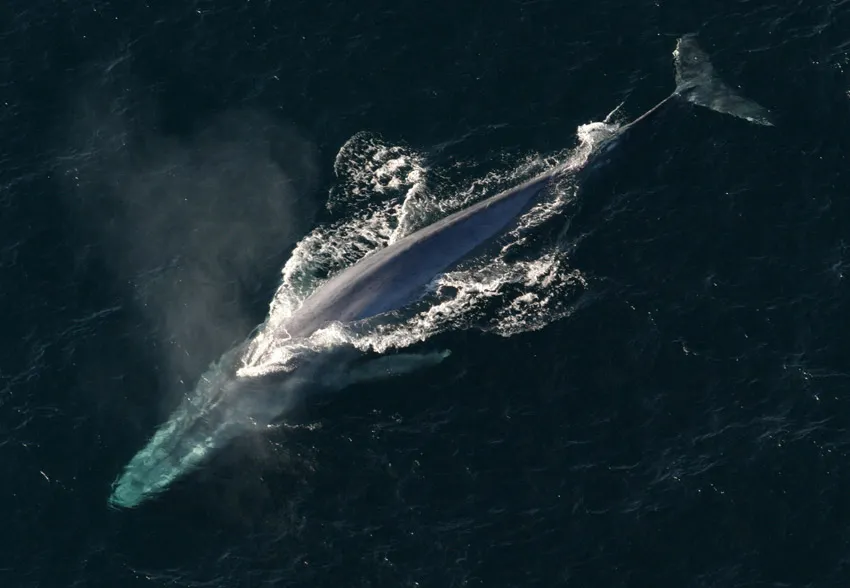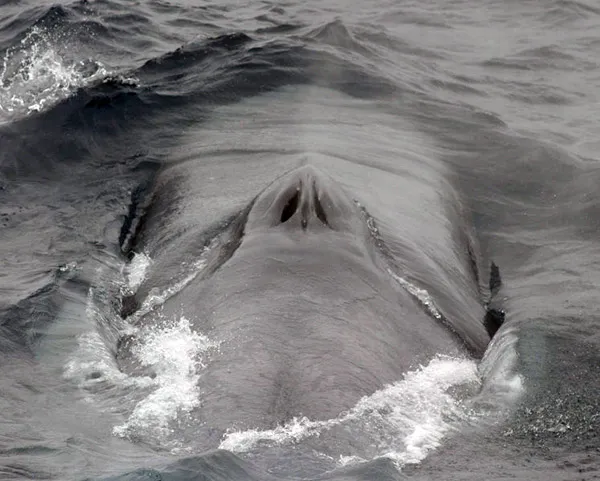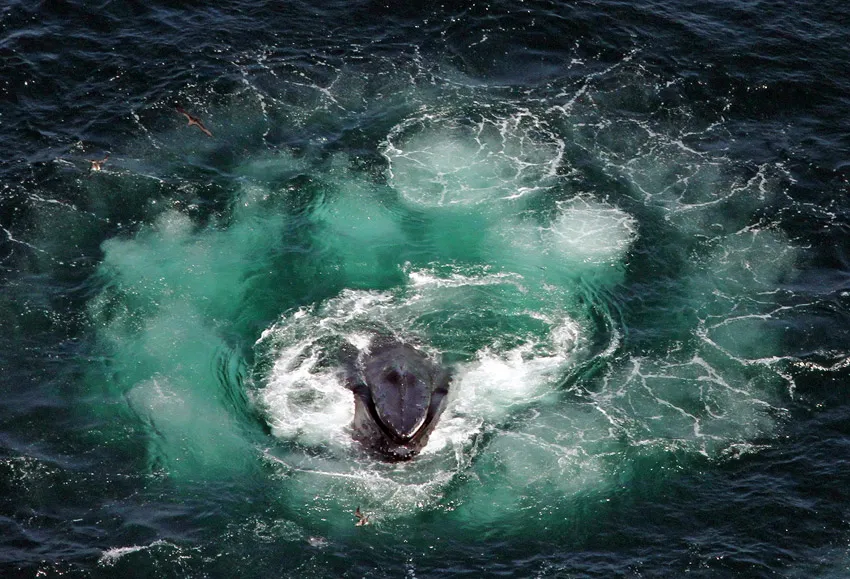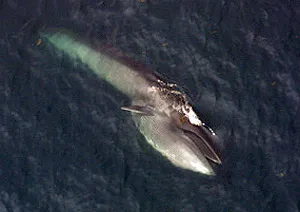Whale Adaptations
Baleen whales - Mysticeti

The largest animals ever to have lived, larger than any
dinosaur, their huge bulk being supported by the sea. Not exclusively
Antarctic animals but often found in the frigid waters in both
north and south polar regions.
Large whales are able to live indefinitely in the
coldest seas on earth. If you were to fall into the
Antarctic Ocean, you would have about 15 minutes before hypothermia
set in, at this point you may pass out and drown, in any case
you would be dependent on someone else to get you out of the
sea, even if you were kept afloat with a life vest you would
be dead in 60-90 minutes. Whales however can live at the same
temperatures indefinitely if healthy and reasonably fed, they
just don't get hypothermia - ever. The reason for this is that
a large size with a low surface area to volume ratio, and a
blanket of blubber around the whole animal below the skin mean
that metabolic heat is retained to the degree that the coldest
seas are readily survivable.
They have a number of adaptations that enable them to live
and thrive in the Polar regions, these can be broken down into:
- Anatomical - Structures of the body.
- Behavioural - The manner in which animals
move and act.
- Physiological - The internal functions
of the animal from biochemical, to cellular, tissue, organ
and whole organism levels.
Anatomical
Adaptations

 Baleen plates in the mouth instead of teeth to filter
food in bulk from seawater.
Baleen plates in the mouth instead of teeth to filter
food in bulk from seawater. These are made of keratin,
the same tough protein that makes hair, skin, nails, hooves
and horns. There are two rows of plates that hang down from
the upper jaw forming two upright sides of a triangle with the
lower jaw being the third side. The inner edges of these plates
are bristly filters to collect food, usually smallish very numerous
animals such as krill in the water they gulp in. A huge mouthful
of water + food is taken in and the mouth closed, then the water
is ejected by the tongue while the food is filtered out and
trapped inside the mouth to be swallowed when the water has
gone.
 55 - 68 ventral grooves that extend from the lower jaw to the
navel
55 - 68 ventral grooves that extend from the lower jaw to the
navel (yes, whales have a belly button!) These allow
a huge amount of water and food to be taken into the mouth allowing
it to expand to about 6 times larger than normal size (sometimes
a bigger volume than the whale itself). The largest whales (blue
whales) can eat up to 4 tonnes of food a day in the Antarctic
summer, they can feed for about 8 months and then fast for 4
months living off their fat reserves.

 Large whales have stretchy nerves in the muscle of the
floor of the mouth to allow for that expansion with water and
food to take place.
Large whales have stretchy nerves in the muscle of the
floor of the mouth to allow for that expansion with water and
food to take place. This might not seem very significant,
but nerves are generally delicate structures and any stretching
will usually cause serious damage. The nerves in this part of
the baleen whale are elastic with a cord limiter to prevent
damage by over-stretching so preserving the still fragile structure
of the neurones that carry impulses to the muscles that expel
the water from feeding.
Lunge feeding may be a key development
in allowing whales to reach their enormous size, so stretchy
nerves could be a vital component in the evolution of large
whales.
 A ridge in front of the blowholes (the two nostrils) which are
located on top of the head
A ridge in front of the blowholes (the two nostrils) which are
located on top of the head. Pointing backwards means
that they are not filled with water when swimming, being placed
on top of the head makes it easy to breathe while surfacing
and lifting the smallest amount of the body possible, like a
short snorkel.
 A huge tail fin the size of two dinner tables that provide the
main propulsion for swimming.
A huge tail fin the size of two dinner tables that provide the
main propulsion for swimming. The smaller forward fins
are for changing direction and the small dorsal (mid-back) fin
helps with stabilizing straight swimming, it is the tail that
provides the power.
Behavioural Adaptations

 Bubble netting.
Bubble netting. A feeding technique practised by humpback
whales, one or two whales dive down below a shoal or swarm of
prey, fish or invertebrates, they then slowly swim vertically
upwards towards the surface in a spiral. They blow bubbles as
they swim which float up in a circle and panic in towards the
centre. The whale/s then dash straight up through the middle
with their mouths open and get a more concentrated mouthful
of food.
Other whales may come in at this point too,
as the prey flee one predator, they are more likely to blunder
into the path of another, so co-operative feeding helps them
all.

 Lunge feeding.
Lunge feeding. This is a technique whereby
the whale approaches a concentration of prey in the water and
then lunges at them with its mouth wide open and the floor of
the mouth distended enormously to engulf they prey and a large
volume of water at the same time. The water is then pushed out
over the baleen plates with the food being filtered out, so
it is a sort of batch filtering process. It may be combined
with bubble netting and/or co-operative feeding with other whales
to help concentrate the prey for the most satisfying mouthfuls.
 Migration - Many whales migrate to the polar regions during
the summer months of that region.
Migration - Many whales migrate to the polar regions during
the summer months of that region. There are often distinct
southern and northern populations of species which go to their
respective pole, none go to both poles.
They
feed continuously during the super-productive summer months
and then live entirely on their blubber reserves for about 4
months during the breeding season in warmer waters. Not all
individuals migrate however and in recent years, some humpback
whales have been found around Antarctica during the winter rather
than 7,000km (4,350miles) away off the coast of Africa where
they were thought to be.
 Whales use sound to communicate with each other and also possibly
as a means of finding krill swarms.
Whales use sound to communicate with each other and also possibly
as a means of finding krill swarms. Blue whales make
the loudest noise of any animal at 180 dB or more. These sounds
can travel underwater for as far as 500 miles (800 km). They
are very low frequency sounds down to 14hz, below the hearing
limit of humans, though they can be felt by divers in the water
at the time.
Physiological Adaptations
 Large whales have enormous appetites, adult blues have a daily
energy requirement in the region of 6.3 million Kilojoules
Large whales have enormous appetites, adult blues have a daily
energy requirement in the region of 6.3 million Kilojoules
(1.5 million kilocalories). This is supplied by up
to 3.6 tonnes or about 40 million individual krill eaten per
day which all have to be processed by the digestive system.
This drives the "inner furnace" of metabolic heat which keep
the animals comfortable and active in temperatures that would
result in hypothermia and death in most mammals in just an hour
or two.
 Like other air breathing diving animals such as seals, and penguins,
whales have muscles rich in myoglobin.
Like other air breathing diving animals such as seals, and penguins,
whales have muscles rich in myoglobin. This is an iron
containing protein similar to the haemoglobin that carries oxygen
in the blood, but provides an extra in-situ store for longer
dives exactly where it is needed deep in the most active muscles.
 Their metabolism is able to cope with extended periods of plenty
where extensive feeding allows the build up of many tonnes of
blubber
Their metabolism is able to cope with extended periods of plenty
where extensive feeding allows the build up of many tonnes of
blubber (stored fat) which is then used up during extended
periods of starvation, 8 months feeding, 4 months with no food,
but living off the reserves that were built up.
More about whales





